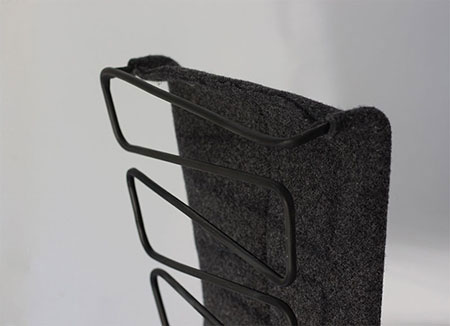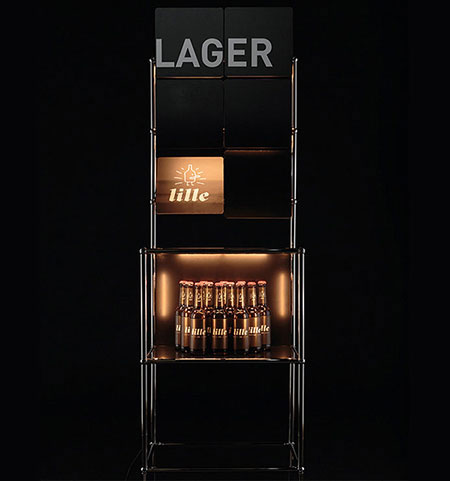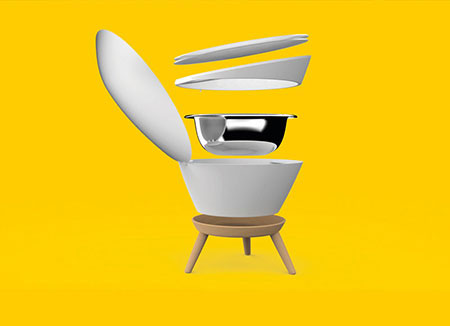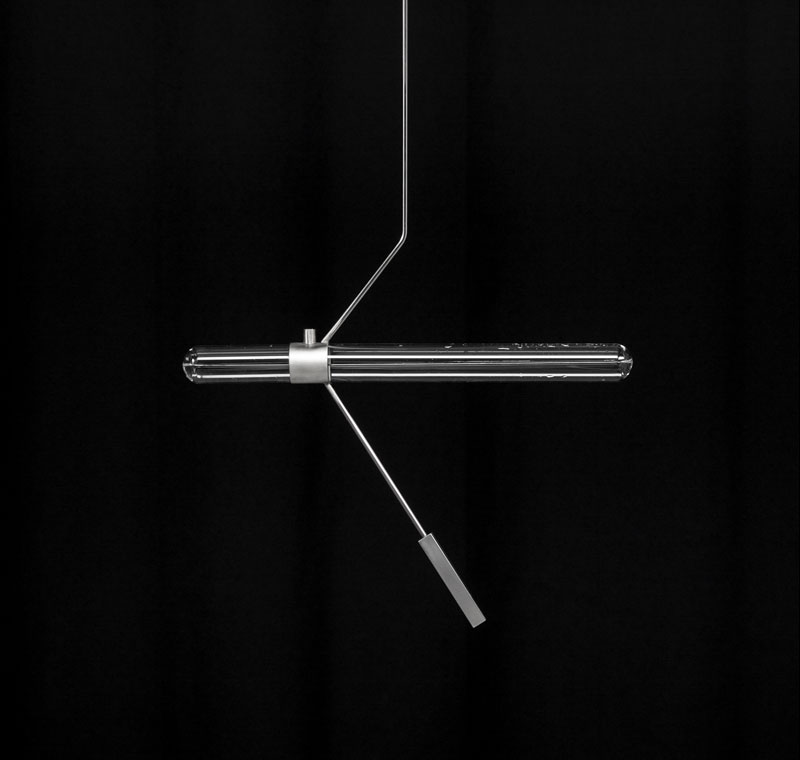
Charles is the solution to the chair, everyone knows.
Charles is the place to keep the clothes you don‘t want to put back into the wardrobe or which are not ready for the laundry. It‘s a quick storage option without interrupting the sitting function.

How could I create something which is used anyway in a different way without the need of extra furniture?
I saw the problem that almost every person has this one chair in their room which is more used for hanging on their clothes than for sitting. So why not combine these things without loosing the comfort of a function?
What is already there? How do people deal with this problem?
I asked people in different target groups how they deal with this: Many people just put their clothes on their bed while using the chair and put it back when they want to go to bed. Others have an extra furniture like a cantilever chair. So I did research on already existing objects.

Fast and structured storage - how does it fit in a room?
I looked for the different opportunities, clothes can be hanged on and crystalized the most simple and comfortable functions: the coat hanger and simple cross strives. But how could I use these without making them look too functional? It may be possible to find a structure which reflects every aspect. I searched for different structures especially in architecture.

Making Mock-ups and building the final model
I built a few mockups in order to check the dimension, the look and the construction. After that I was able to built my final result. I bent aluminium pipes after my technic drawing and combined them with a plug-in connection. After fillering the connection points and spraying the hole stuff, I stitched the seat and rest surface.
Charles
2. Semester
Nicole Häring

Co-Cooperation with USM Haller and Lille Bräu
This Project is a shop concept in cooperation with USM Haller and in our case with a small brewery called ‚lillebräu‘. The concept „brew up“ basically consists of beer tap modules and a customizable tiled wall. Both are perfectly integrated into the Haller E system and especially the modular tiled wall increases the possibility of customization significantly. By adjusting the angle of the tiles you have full control over your highlighted parts. With the changeable magnetic foil you have the freedom to display any kind of graphics or information.

Tiled wall
Even small objects like ingredients can be presented. Anodised aluminium is used on the back for getting diffuse light reflections. The tiles are fixed with simple clips and can be easily clicked on and off. The clips are based out of the center of the tiles for better control of the light.

Beer tap station
The beer tap station offers a customer experience you usually miss in conventional stores. Users can try the different beer types and get a quick overview of the sortiment. The system is modular, you can add as many kinds as needed. On top, we used the Haller E furniture to storage the glasses and hang in bulbs to create a pub atmosphere.

Scenario
Brew up can be used in various set ups. For example for a pop-up store: The beer tap station could build the center and the tiled wall can be used as a space separation. The warm light and the raw materials gives the costumer a cozy atmosphere.

Raise me up but don‘t let the muscles suffer.
It‘s an ergonomic body you wear under your clothes which helps you get a better posture. It consits of two parts: the rebuild s-curve to support the muscles and the x-stripes which you can adjust by yourself to support and remind your shoulders to get back in the right position.
Every third adult has problems with their back.
And most of them are the result of false posture, for example because of the long time that people spend in front of a computer. We thought about a solution which is nearly invisible and reminds and supports you while sitting but also while walking around.

Creating a balanced posture for the whole back
The rebuild s-curve consists of two structures going around the spinal column. They have a fixed position but allow moving with tension. The wide elastic band is crossed at the back and guided along the chest to avoid constriction. You can fix and adjust the tension on your own by hanging them into different checkmarks.
„Evolutionary, humans are not built to sit in the chair all the time.“
We talked with Dr Keller, a doctor of orthopedics for a better understanding regarding this subject. He explained that there wasn‘t the one position for sitting and that it was best to change postions mulitple times. The main problem is that people get a relaxed posture so the back isn‘t in the natural s-curve and the shoulders fall in front. The other point is that it is good to have support for the lumbar vertebra and because of that, your whole spinal column gets in form.

We did research on what was already on the market and what users critizise about these products
There are a lot of gadgets with the x-stripe to hold back your shoulders. But most are out of an unflexible material and your muscles don‘t have to work anymore. That is why you can only wear them for a couple of hours otherwise the muscles will diminish.
Testing on our own
We made first tests and mock ups, to try different tools. By taping our shoulders with an x, we noticed that it reminds you when you fall back into your old posture only because of the traction. To try the rebuild s-curve we sewed unflexible stripes in the right form into a shirt. The first problem we had was that the stripes were to unflexible so the changing of the sitting postion failed. The other problem was that the shirt constantly slipped off.

Bulding the final model
For the final model, we took two lines of polystyrol and sliced them into different angles we first calculated to have in conclusion to the natural s-curve. We put them on a medium elastic band so that it was still flexible in both directions. We put magnets to the connection points, so you get easily in the ‚right‘ postion and get a tactile and accoustic feedback if you‘re in an upright position.
Sundra is a sunoven. You can cook and bake only with the energy of the sun without the need of electricity or fire.
We want and we have to use the energy that is already there. Sundra is sustainable, healthy, produces no smoke and gives a conscious experience. It can be taken to a picnic or be positioned on the terrace and bake bread. Wherever the sun shines - it won‘t bother anyone.
We wanted to redesign the classic solar oven and its rudimentary appearance and make it accessible to everyone.
Anna‘s grandmother regularly uses her self-built sunoven to bake bread and cakes. The disadvantage: the oven is very large and rudimentary. Our goal was to move away from the boxy form and create a compact, easy to use oven that fits everywhere and is reduced in its appearance.

Sunrays hit the adjustable parabolic mirror, get bundled and redirected. The rays go through the double glazing and heat up the insulated body that stores it.
The double glazing is fixed to the rotating cap which enables the opening of the sun oven. A rubber insulates the cap and the body. Inside is a removable stainless steel bowl for cleaning in the dishwasher. The whole body fits in the removable bases for a good stand on different surfaces.

We have compared the different types of solar ovens and tried to combine the best of everything.
In order to focus the sun‘s rays, we have decided to use a parabolic mirror.In order to use the space of the cooking area perfectly, we have decided on a round basic shape. We wanted to create a user-friendly product that is as close as possible to the normal cooking and baking process.
We built three different prototypes and tested them all.
With the third prototype we reached the highest temperature the fastest, but in all of them the temperature dropped quickly once the sun was gone.

The prototype reached over 150°C and we were even able to bake a bun and cook vegetables in 1:45 hours.
The double glazing is fixed to the rotating cap which enables the opening of the sun oven. A rubber insulates the cap and the body. Inside is a removable stainless steel bowl for cleaning in the dishwasher. The whole body fits in the removable bases for a good stand on different surfaces.

After the basic form followed the function and was already relatively defined, we thought about the best way to open the oven, what it should stand on and how big it should be.
We decided to keep everything very simple. For opening we decided to overlap the parabolic mirror with the basic form. For the base we chose a classic 3-legged construction to ensure a good stand on different surfaces. For the size of the stove we have chosen the smallest possible variant. You can easily take it with you and prepare meals for 1-2 people.
Sundra
6. Semester
Anna S., Katharina K., Nicole Häring

All my life I have been confronted with chaos: „Don‘t be so chaotic, how can you be comfortable here?“
For me it was not bad at all, because I mostly found my way around and just acted intuitively. Thats why I dealt with the topic for a long time and found out that behind every chaos there is a certain order, which is just not immediately recognized as such. For example the chaos pendulum, which at first swings uncontrolled over three magnets, shows a uniform fractal picture by iterations with the help of computer simulation.
I want to design the chaos and create an orderly disorder.
Humans always try to understand and comprehend everything, always try to bring a structure into everything. We strive for the divine order, how else are we supposed to function? I am aware that a certain order is important and necessary. Nevertheless I believe that chaos has a great potential.

Why is chaos so negatively affected in everyday language?
Chaos is the behavior of deterministic, non-linear dynamic systems. In philosophy, chaos is the uncreated, not yet existing. In everyday life it is often equated with confusion, disorder, loss of control and unpredictability.
My idea is to work out the positive aspects and possible applications by understanding and applying chaos and analyzing chaotic behavior in persons.
I have clustered the project into three areas: definitions, everyday life and fractals, based on my research and approach to the project. To illustrate my research and to give an idea of the applications, I have used a fractal shelf system to show different chaotic behaviors. This project is not finished yet, this only shows an intermediate state of my work.

In order to understand why people act the way they do, I asked 90 people if and why they think chaos is efficient and the opposite, why they keep order and what bothers them.
From this and from my previous research, I made my demands on a Chaotic System. It has to be flexible and dynamic, there has to be room for individual use/behavior and therefore it should be adaptable. One should be able to keep a rough overview. In addition, the focus should be on efficiency. It should save time and be adjustable to everyday life. It should be fun and satisfy the user. Overstrain should be avoided and concentration should be strengthened. It is important that it remains simple and allows intuitive use. It should allow room for coincidences.
It should avoid the complete loss of control, stress, excessive demands, fixed places and restrictions in individual actions.

In my survey, I asked people where chaos occurs in their everyday life. The most frequent answers were in the thoughts and on the desks.
I found it exciting, because the inner disorder has a great influence on the outer chaos. The desk is the place where the thoughts are put down on paper and therefore qualified for closer inspection.
I have had many pictures of desks sent to me in their current state. I have scribbelt some of them and analysed which things are located in which areas and what the desk is used for.
Often unimportant things or things that are not used so often are intuitively put on the back or the edge. It is also used for eating, drinking and storing small everyday objects. Digital media take up more and more space and the actual work area is limited to a small part in the front in the middle. The analysis is not yet complete, but these are the first findings.

You need to allow people to create their space.
In my opinion, the workplace is mainly about the surroundings, creating a good atmosphere but the desk itself is static and linear and in principle always the same.
What if the basis, the desk itself, was adaptable, dynamic and intuitive to support the user‘s behaviour?
Here are a few possible functions. My goal is to combine different applications in one desk. But it should not be overloaded or technical. Everything should be kept as simple and minimalistic as possible and still allow many applications.
Chaos
6. Semester, ongoing
Nicole Häring
The fascination that microalgae with their numerous properties have triggered in us is presented to the outside world in the form of an informative exhibition with illustrative applications.
Within the framework of our bachelor‘s thesis we dealt with the fascination of microalgaes. „Fascination Microalgae“ lets the exhibition visitor experience the potential of microalgae by means of exemplary applications. A guidance system symbolically guides microalgae into the experimental applications of colour pigments, omega-3 fatty acids, antiseptics, air purification, bioluminescence and energy production.

From the many properties we have chosen the most fascinating and the most accessible properties for everyday life.
The first four characteristics, Photosynthesis, growth, no competitior and biodegradable are generally valid for all characteristics. The rest are specific characteristics, which we present in an exemplary way and make the subject of the exhibition. Excluded is the property photosynthesis, which is the most important one, we wanted to thematize in the exhibition.

We built a room for the exhibition, which was allowed to be about 2x3 meters large due to the limited space for the semester exhibition at our university.
Through tests we positioned the applications and built a room within the room to provide darkness for the bioluminescence. The room is partially transparent so that the illuminated microalga Chlorella vulgaris, which we cultivated ourselves, can shine through and attract visitors. A guide symbolically leads the microalgae of Chlori into the different applications and guides the visitor to them. In front of the applications there are short information texts to describe them in more detail.

A wide spectrum of natural color pigments can be extracted from microalgae by combining the various colouring substances, such as chlorophyll and phycocyanin.
These colour pigments are environmentally friendly and can be used to dye textiles, for example, without the need for chemicals. Some are even food safe and are already used in the food industry. For example, the only natural blue dye is extracted from microalgae.
In the exhibition we show a high-quality textile print but also examples of different dyed fabrics and the corresponding colour pigments in a petri dish.
We want to give the visitors an idea of what is possible but still not show a concrete product, in order to keep the many possibilities open and to maintain the experimental character of the exhibition.

Omega-3 fatty acids are important for the normal functioning of our heart, our sight and our brain.
These fatty acids are polyunsaturated fatty acids which the body cannot produce itself, so they have to be supplied through food. The daily need of omega-3 fatty acids is 2000 mg, so nearly everybody has a deficiency to it. Probably the best known source of these fatty acids is fish, such as salmon. However, fish only has them because it previously consumed them through algae.
Should we rather eat 250g of salmon a day or consume a glass of microalgae?
In the exhibition we want to demonstrate the possibility of cosuming fresh microalge: from a tap embedded in the wall, one can symbolically draw microalgae liquid from the pipe. The advantage of drinking microalgae fresh is that they have no fish smell, as they have not yet oxidized.

Ingredients from various algae are effective against multi-resistant pathogens and can prevent the outbreak of diseases.
For example, the cyanobacterium Anabaena acts against multi-resistant pathogens such as the MRSA virus. Also ingredients of the red alga Delisea pulchra, so-called furanones, are said to prevent communication between the bacteria and thus the outbreak of diseases such as cholera, tuberculosis and food poisoning.
We want to provide information about the antiseptic effect of algae and exhibit an antiseptic gel that can be interpreted as hand disinfection, for example.
In order to radiate purity and fascination, the algae gel is a clear gel with a greenish-bluish glow.

Algae convert three times as much CO2 into oxygen as crops. We would like to emphasize this probably strongest property even more and demonstrate the air-purifying effect.
In order to be able to absorb as much CO2 as possible and release oxygen, living algae are placed on a moisture-absorbing surface. This surface must be watered about every two weeks so that the algae can survive on it.
We have decided on a three-dimensional surface structure, so that the surface can be maximized on a small surface area.
The design remains very neutral and experimental, so that visitors to the exhibition can imagine the living algae air purification both in their own homes and in an urban context.

Some algae, for example the Dinoflagellates, have bioluminescent properties. They light up as a result of disturbances such as movement.
We communicate this fascinating property, also known as marine luminescence, in the exhibition using a pendulum. We have done many tests to see which movement best represents the fascination and have chosen this smooth and linear movement to keep the focus on the fluid.
The visitor can push the pendulum in the separate dark room and admire the algae that shine through it.
The design of the pendulum is minimalist and yet, due to its asymmetry, it still has an exciting effect even in its resting state. To reflect the experimental character of the exhibition, the main parts of the pendulum are test tubes. Through the round ends of these, the liquid makes undulating movements, reminiscent of the sea.

Due to their photosynthetic properties, algae can convert light into electricity. During photosynthesis, electrons are produced, which partly can be collected and stored.
All that is needed is light, CO2, the algae themselves and a low energy consumption. For our luminaire we use an LED and an additional battery to store the energy.
Like the bioluminescent pendulum, the lamp is mainly made of test tubes to keep its experimental character:
the container in which the algae liquid is kept and gets light thanks to the transparency and the diffuser, which is cut and sandblasted. Both parts are connected by a sleeve in which the electronics are installed. To supply the algae with CO2 , one can bubble in through the tube mounted on top.





